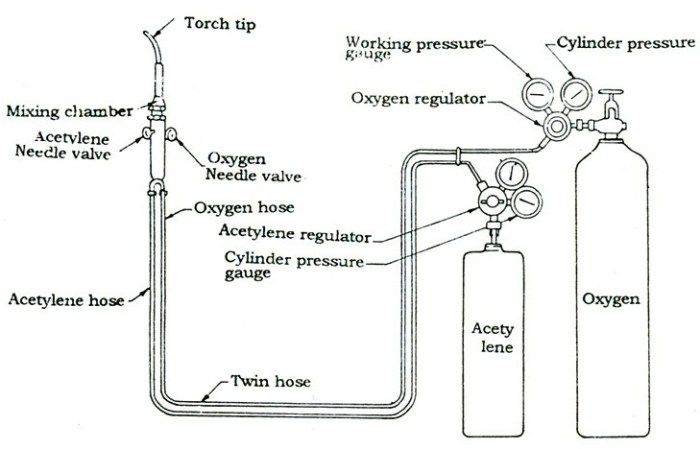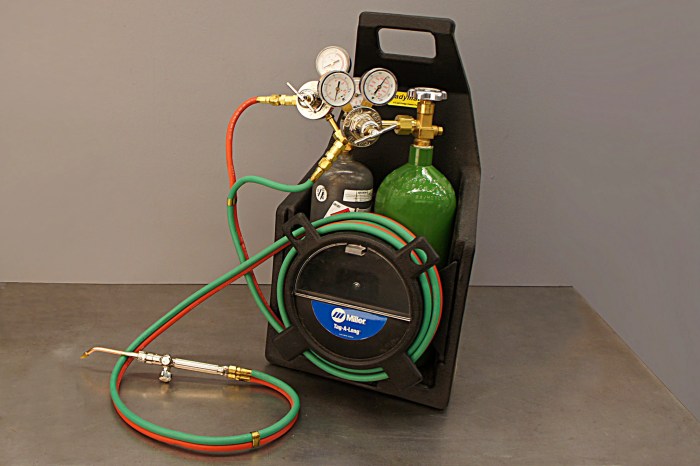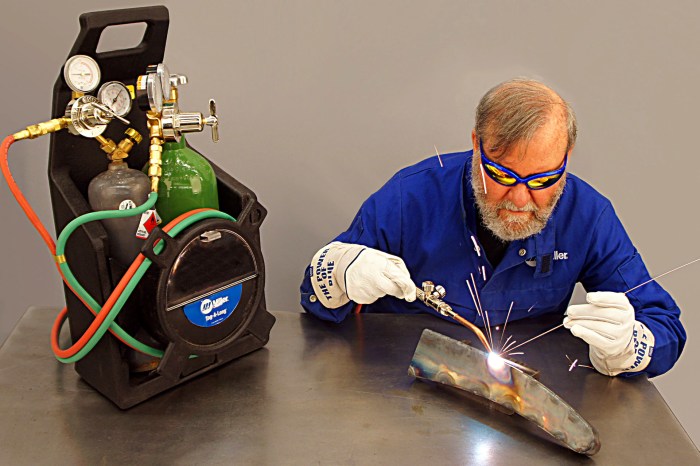Oxy acetylene gas welding equipment, a cornerstone of the welding industry, has revolutionized metalworking processes since its inception. This versatile tool offers a wide range of applications, from intricate fabrication to heavy-duty construction projects. In this comprehensive guide, we delve into the world of oxy acetylene gas welding equipment, exploring its components, applications, safety considerations, and more.
Oxy Acetylene Welding Equipment Overview
Oxy acetylene welding equipment is a type of welding that uses a mixture of oxygen and acetylene gases to produce a high-temperature flame for welding metals. It is a versatile welding process that can be used to weld a wide range of metals, including steel, stainless steel, aluminum, and cast iron.
Oxy acetylene welding was developed in the late 19th century and quickly became the most popular welding process. It was used extensively in the construction of ships, bridges, and other large structures. However, in recent years, oxy acetylene welding has been largely replaced by other welding processes, such as shielded metal arc welding (SMAW) and gas metal arc welding (GMAW).
Advantages of Oxy Acetylene Welding
- Produces a high-temperature flame that can weld a wide range of metals.
- Versatile welding process that can be used for a variety of applications.
- Relatively inexpensive equipment.
- Portable welding equipment that can be used in a variety of locations.
Disadvantages of Oxy Acetylene Welding
- Produces a large amount of heat, which can be a hazard.
- Requires a skilled welder to operate safely.
- Not as fast as other welding processes.
- Can produce fumes and gases that can be harmful to health.
Components of Oxy Acetylene Welding Equipment: Oxy Acetylene Gas Welding Equipment
Oxy-acetylene welding equipment consists of several essential components that work together to create a controlled and safe welding environment. Each component plays a specific role in the welding process, and understanding their functions and specifications is crucial for ensuring efficient and safe operation.
Welding Torch
The welding torch is the primary tool used to direct the oxy-acetylene flame onto the workpiece. It consists of a handle, a mixing chamber, and a tip. The handle provides a comfortable grip for the welder, while the mixing chamber combines the oxygen and acetylene gases to create the welding flame.
The tip, also known as the nozzle, controls the size and shape of the flame.
Safety features of the welding torch include a flashback arrestor, which prevents the flame from traveling back into the hoses, and a flame arrester, which prevents sparks from escaping from the torch.
Regulators
Regulators control the flow of oxygen and acetylene gases from the tanks to the torch. They consist of a pressure gauge, a flow control valve, and a safety relief valve. The pressure gauge indicates the pressure of the gas in the tank, while the flow control valve adjusts the amount of gas flowing to the torch.
The safety relief valve releases excess pressure from the regulator in case of a malfunction.
Safety features of the regulators include a check valve, which prevents the gases from flowing back into the tanks, and a burst disc, which ruptures in case of excessive pressure.
Hoses
Hoses connect the tanks to the regulators and the torch. They are typically made of rubber or plastic and are reinforced with a metal braid to withstand the high pressure of the gases. Hoses are color-coded to indicate the type of gas they carry: red for acetylene and green for oxygen.
Safety features of the hoses include a flame-resistant coating, which prevents the hoses from catching fire in case of a leak, and a pressure relief valve, which releases excess pressure from the hoses.
Tanks
Tanks store the oxygen and acetylene gases used in the welding process. They are typically made of steel and are equipped with a pressure gauge, a safety relief valve, and a valve to control the flow of gas. Tanks are color-coded to indicate the type of gas they contain: white for oxygen and red for acetylene.
Safety features of the tanks include a fusible plug, which melts and releases the gas in case of excessive heat, and a check valve, which prevents the gases from flowing back into the tanks.
Oxy Acetylene Welding Process

Oxy acetylene welding is a versatile and widely used welding process that utilizes the combustion of acetylene and oxygen to generate a high-temperature flame for joining metals. This process involves several key steps, each of which plays a crucial role in achieving optimal weld quality.
Preparation, Oxy acetylene gas welding equipment
Prior to welding, the surfaces to be joined must be thoroughly cleaned to remove any dirt, grease, or other contaminants that could interfere with the weld. The edges of the metal pieces should be beveled to create a V- or U-shaped groove, which allows the molten metal to flow into and create a strong bond.
Ignition and Flame Adjustment
The welding torch is ignited by opening the acetylene valve and then lighting the gas with a spark or flint. Once the acetylene is burning, the oxygen valve is opened and the flame is adjusted to achieve the desired characteristics.
The flame should be neutral, with a slightly reducing inner cone and a slightly oxidizing outer cone. This flame adjustment is critical as it affects the temperature and the oxidation-reduction potential of the flame, which in turn influences the weld quality.
Welding Technique
With the flame properly adjusted, the welder begins to weld by directing the flame at the joint between the metal pieces. The torch is held at a slight angle to the joint, and the molten metal is allowed to flow into the groove.
The welder must maintain a steady hand and a consistent travel speed to ensure a uniform weld bead.
Post-Welding
Once the weld is complete, the metal is allowed to cool slowly to prevent cracking. In some cases, the weld may be annealed to further improve its strength and ductility. The welded joint is then inspected to ensure that it meets the required specifications and standards.
Tips for Optimal Welding Results
* Use clean, high-quality welding gases.
- Adjust the flame to achieve a neutral flame with a slightly reducing inner cone.
- Maintain a steady hand and a consistent travel speed.
- Allow the metal to cool slowly after welding.
- Inspect the weld to ensure that it meets the required specifications and standards.
Applications of Oxy Acetylene Welding

Oxy acetylene welding is a versatile welding process widely used in various industries and applications due to its portability, affordability, and effectiveness in joining metals. The process involves the combustion of oxygen and acetylene gases to produce a high-temperature flame that melts the metal, allowing for fusion and bonding.
Industries Using Oxy Acetylene Welding
Oxy acetylene welding is commonly employed in the following industries:
- Automotive repair and fabrication
- Construction and metalworking
- Plumbing and pipefitting
- Shipbuilding and marine engineering
- Aerospace and aircraft maintenance
Specific Welding Projects
Examples of specific welding projects where oxy acetylene welding is used include:
- Repairing cracked engine blocks and exhaust systems in vehicles
- Fabricating metal structures, such as railings, gates, and fences
- Joining pipes and tubes in plumbing and HVAC systems
- Welding hull plates and repairing structural components in ships
- Performing maintenance and repairs on aircraft fuselages and engine mounts
Suitability for Different Metals
Oxy acetylene welding is suitable for welding a wide range of metals, including:
- Steel (mild steel, stainless steel, etc.)
- Iron
- Aluminum
- Copper
- Brass
The versatility of oxy acetylene welding makes it a valuable tool for fabricators, welders, and technicians across various industries.
Safety Considerations in Oxy Acetylene Welding

Oxy acetylene welding involves the use of highly flammable gases, which poses potential hazards that must be carefully managed to ensure a safe working environment. These hazards include fire, explosions, and exposure to toxic fumes.
Importance of Proper Ventilation
Adequate ventilation is crucial to prevent the accumulation of flammable gases and toxic fumes. Proper ventilation systems remove these gases and fumes from the workspace, reducing the risk of explosions and exposure to harmful substances.
Importance of Protective Gear
Protective gear, including fire-resistant clothing, gloves, eye protection, and respiratory protection, is essential to safeguard the welder from potential hazards. Fire-resistant clothing protects against sparks and flames, while gloves prevent burns. Eye protection shields the eyes from harmful radiation and flying debris.
Respiratory protection, such as respirators or air-supplied helmets, prevents inhalation of toxic fumes.
Safe Work Practices
Safe work practices are essential to minimize risks. These include:
- Inspecting equipment regularly for leaks or damage.
- Ensuring proper gas flow and pressure.
- Maintaining a clean and organized work area.
- Storing flammable gases properly and away from ignition sources.
- Following proper lighting and ventilation guidelines.
Safety Regulations and Industry Standards
Various safety regulations and industry standards govern oxy acetylene welding to ensure safe practices. These include:
- Occupational Safety and Health Administration (OSHA) regulations
- American Welding Society (AWS) standards
- National Fire Protection Association (NFPA) codes
- Local building codes
Compliance with these regulations and standards is essential to maintain a safe working environment.
Essential Questionnaire
What are the advantages of using oxy acetylene gas welding equipment?
Oxy acetylene gas welding equipment offers several advantages, including its versatility, portability, and ability to weld a wide range of metals. It produces a high-temperature flame, allowing for precise and controlled welding.
What safety precautions should be taken when using oxy acetylene gas welding equipment?
Oxy acetylene gas welding equipment requires strict adherence to safety precautions due to the potential hazards associated with flammable gases. Proper ventilation, protective gear, and safe work practices are essential to minimize risks.